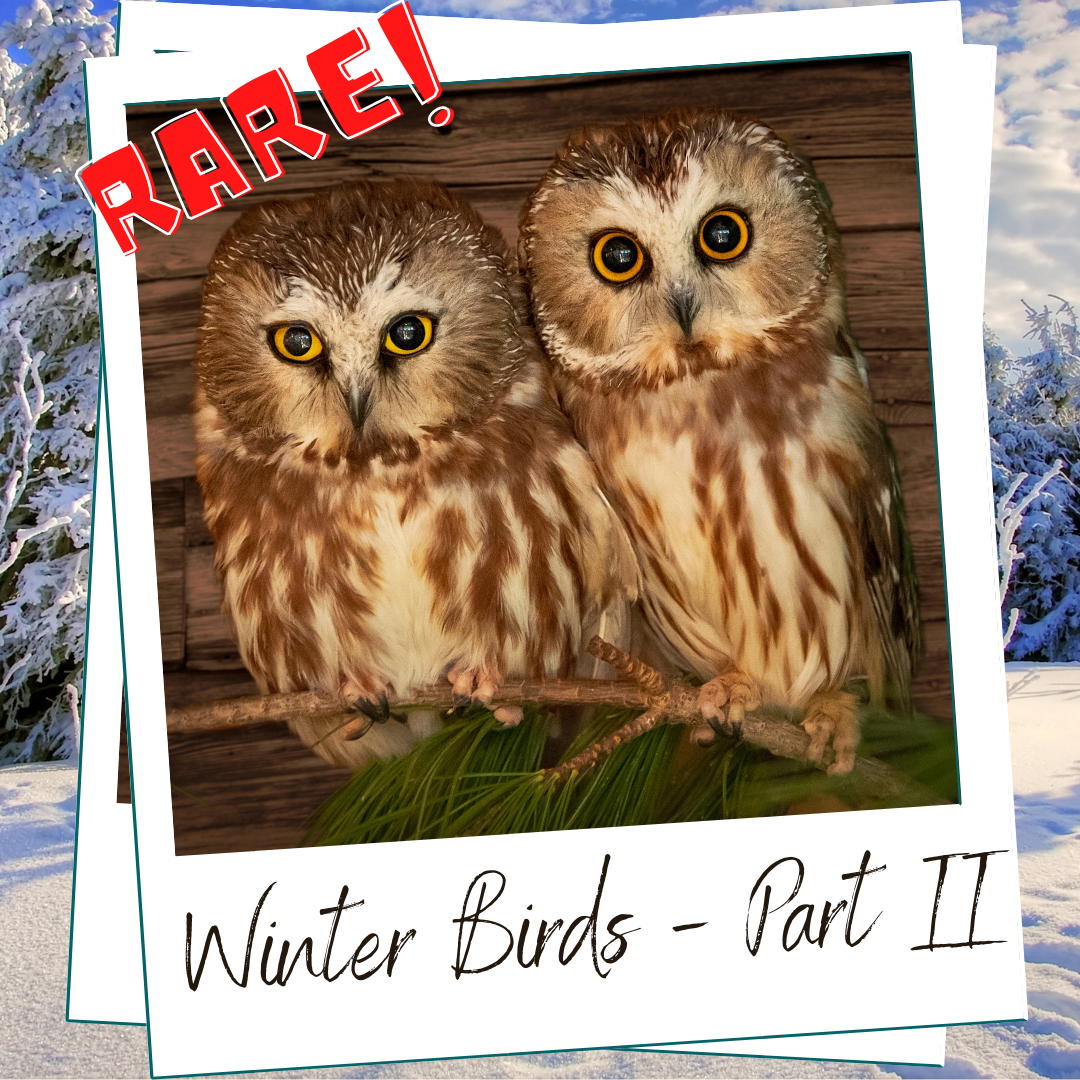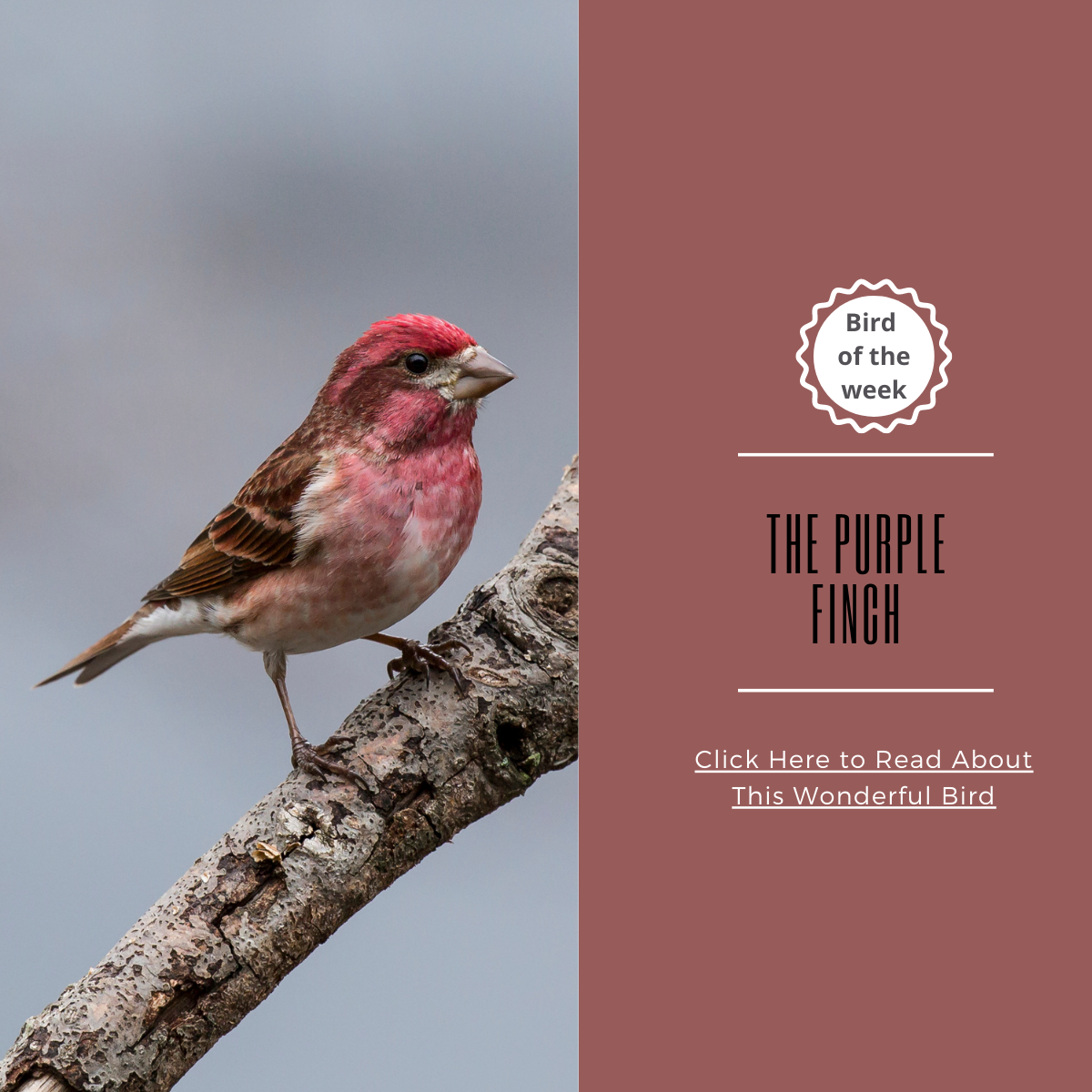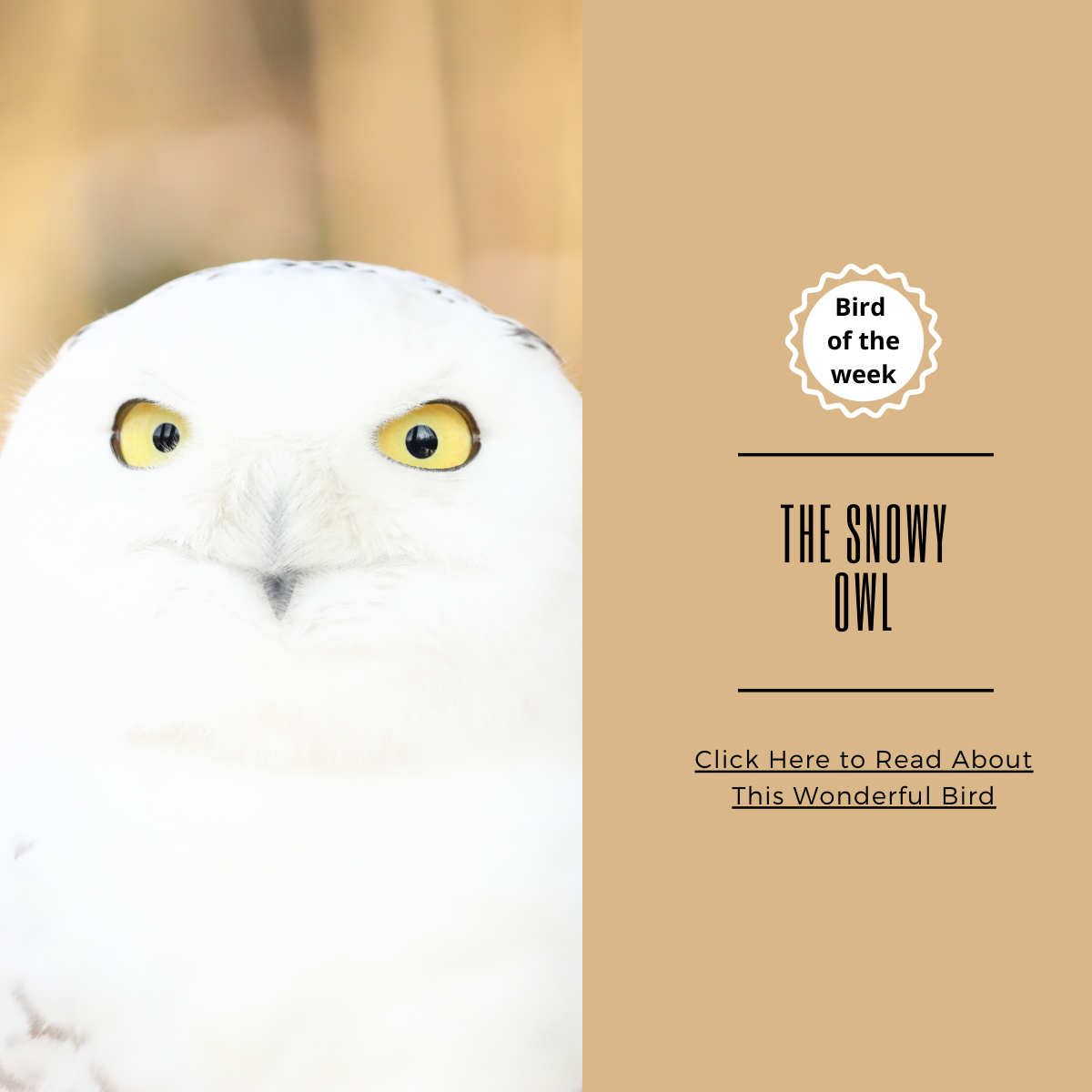
There are those of us bird lovers who choose to walk for miles in the snow just to catch a glimpse of a rare winter bird. They will sit patiently in the freezing cold, hoping to get a glimpse of that unique wonder. Then there are those of us who are just plain lucky to have these magnificent flyers suddenly appear right outside our kitchen window.
Whichever way you see them, any winter spotting of a rare bird is a magical, serendipitous moment.
This winter of 2021 is filled with many of these sightings and the reason we are seeing so many rare birds south of the Canadian Boreal forests, is because of an ecological phenomenon called:
IRRUPTION
Irruption is a sudden change in nature, an unexpected influx of a certain kind of species, usually due to fluctuations in food supply.
Ornithologically, this means that birds who would normally winter in the north are running out of food resources and have to fly further south to find nourishment.
However it could also be from the opposite reason, a phenomenon called masting:
This is when a tree species has an overflow of food, for example, oaks producing many more acorns than usual. As there is competition for breeding territories due to overpopulation, some birds are driven further south, mainly the young and inexperienced birds, to find other, less competitive breeding territories. This is why we see them in our part of the world.
So - a good masting area can lure birds to its area and a poor production of seeds in another area can push the birds away.
Irruption is unpredictable. Academics and amateurs have been scratching their heads for decades. And as irruption can be tied to climate change it piques the interest of ornithologists as well as climatologists.
So with that in mind, we have compiled a list of birds that have flown our way for a better chance of foraging. They will be keeping company with the “usual” winter birds such as eastern bluebirds and northern cardinals of winter.
Whether it’s the snowy owl or the purple finch - it sure is an extra bonus to get a visit from these majestic creatures. So scroll, enjoy and hopefully you'll even get to see them right in your yard!
Let’s start with the finches…
For finches, this winter has seen the greatest irruption in recorded history! Here are a few that may very well visit your bird feeders.
1. Common redpoll

This small finch is around the size of a goldfinch but rounder and plumper. They have a small red cap, black mask and throat and a yellow bill. Males may have a rosy pink spot on their breast.
They fly in large flocks, sometimes with goldfinches and siskins and breed in open forests and willow tundra. They are regurgitators: they stash seeds in their esophagus and “keep them for later”.
Common redpolls love nyjer seed - a great way to lure them to your garden.
2. Hoary redpoll

A hard one to identify.
Most say it’s the “frostier version” of the common redpoll, i.e with whiter chests and reduced streaking.
This northern finch species - like the American tree sparrow - usually breeds in the arctic tundra, nesting in shrubs or crevices of rocks. Since November 2020 they have been spotted further south than usual, flying in flocks, picking seeds off the ground or from plants, shrubs and stunted trees. It is quite amusing to see them upside-down as they peck seed or insects. If you see a group of common redpolls, look carefully - among the flock, you might find a hoary redpoll as they like flying together.
Which side do you think is the hoary redpoll and which side is the common redpoll?
Hard hey?
The left side is the hoary, the right side is the common redpoll.
3. Red-breasted nuthatch

An “honorary winter finch,” red-breasted nuthatches arrive at our bird feeders as early as July, earlier than many irruptive songbirds so perhaps you've spotted them already? It would be easy because they are almost as noisy as the pine siskins!
These tiny birds hail from the northern woods and western mountains. With their long bills and short tails, they flock together with chickadees, kinglets, and woodpeckers. They feed off insects which they excavate from the bark of tree branches and trunks.
Red breasted nuthatches are coniferous songbirds, eating from spruce or fir cones.
4. Pine siskin

A good chance you will see this little finch first because they are the noisiest and most fearless at your bird feeders!
Pine siskins are about the size of a goldfinch, with thin streaks all over its body and the top of its head. Its bill is tiny and narrow, and it often has yellow in its tail and wing bars. They are noisy and fun to watch, and the greediest bird you will host!
They breed all over Canda but are now irrupting in the northern US.
At feeders, these finches don’t stop for much other than thistle seed, or other seeds small enough for their narrow bills.
5. Evening grosbeak

Irruptive movements of the evening grosbeaks are well underway, flocking mainly from Quebec toward Ontario, and the Northeast US all the way down to Florida.
Whomever named this songbird gave the world the wrong impression, thinking that evening grosbeaks tweet only at dusk. Not so, they sing all day, just like the other finches.
They are not easy to miss. The male is quite sizeable, mustard-yellow coloured with a big pale bill and a gold eyebrow. He has large white patches over his back and unlike other finches, he flashes black wings in flight. Females are mostly gray with a light yellow hue on their patches and less white in the wings.
These are delightful to see at our bird feeders and we can tempt them with their favourite food - sunflower seeds. In winter, seeds and fruit are their main menu, as well as nuts. In the summer they go for invertebrates and insects.
A very interesting behavior is their fruit eating. They will grab a cherry, fly back to their perch to remove the flesh and skin, and then actually munch on the seeds inside! Their large bills can create up to 125 pounds of pressure, more than enough to crack the cherry pit.
At feeders, this species prefers larger seeds, like black-oil sunflower.

6. Red crossbills
Just looking at this sweet songbird, you can see his speciality: the unique “crossed bill”. This unique bill allows the crossbill to feed from unopened cones. They love the seeds of pine, hemlock, spruce and fir - and are dependent on these seeds, even in winter.
7. Purple Finch

The scientific name for the purple finch is Haemorhous purpureus. Haemorhous is derived from the greek word “haemo” - blood. Though morbid, this accurately describes the dark red plumage. Hence the Purpureus, which means purple or dark red.
It’s so interesting to see them suck the nectar of the flower or fruit - leaving nothing behind. It also crushes the bases of buds and flowers to extract nectar and feeds on small fruits, eating both seeds and pulp. This seemingly leaves nothing behind for pollination, the reason flowers so generously offer their nectar and seeds, but it actually gives these plants a chance to rejuvenate.
Furthermore, purple finches also eat crop-damaging cutworms, caterpillars, plant lice and weed seeds, particularly those of ragweed and burdock. Purple Finches often visit backyard feeders for sunflower and thistle seeds in winter, especially now during this irruption year.
It is easy to confuse the purple finch with the house finch. Purple Finches are dipped in that rosy-red wash all the way down their wings and back, and a thicker bill. The house finch has a cleaner look.
Can you guess which is the purple finch and which is the house finch?

The purple finch is on the left!
At feeders, Purple Finches love to eat safflower seed, black-oil sunflower and thistle seed.
Just a few days ago, the purple finch was chosen as the Nature Anywhere bird-of-the-week. Take a good gander at it!
8. Bohemian Waxwings

Bohemian waxwings are here not so much as a result of irruption but more from a gradual population increase in the last few years. More and more of these gorgeous creatures are flying from western Canada and Alaska, wintering further south toward our bird feeders!
Bohemian waxwings are found in semi-open country but will end up where food is available. This can be in urban areas as well as any fields and backyards blooming with berry and fruit sources such as crab apples, mountain ash berries, rose hips, and juniper berries. They peck from the wild as well as the native variety and ornamental plants and shrubs. They eat much of the fruit since insects, their main summer staple, are now scarce.
You will know they are close by the high-pitched trills with which they call each other when flying in flocks. As the sounds get close, you'll also see them grouping on fruit trees and berry shrubs.
Their migration pattern is unpredictable. They find fruit pretty much anywhere so you never know where they will show up and when! Hence their name, Bohemian. Because of this nomadic nature.
Be careful not to confuse them with the Cedar Waxwings! Both are gorgeous to look at and the visual differences between the two species are subtle; Bohemians are pudgier and grayer with a rusty coloration under their tails, while cedar waxwings are slimmer with lighter plumage color and a yellow tinted belly. In addition, their songs are absolutely different. The Bohemian song has a high pitched trill whereas the cedar waxwing has a beautiful harmonious tweet.
But despite the differences, both waxwing species can get drunk from over fermented fruit!

Can you guess which is the bohemian waxwing and which is the cedar waxwing?
The Cedar waxwing is on the left.
9. The Northern Saw-Whet

One of the most common owls in northern America, this is one of the smaller owls, about 8 inches long, weighing 5 ozs.
Other than the usual irruptive reasons, over-production of seeds or the lack thereof, saw-whets who migrate from Canada via inland routes were pushed toward the coastlines due to an unbearable cold front. This has happened before and could be the reason we are seeing so many of them this year in northern US.
With his head disproportionately big and bright searing yellow eyes, the northern saw-whet owl is gorgeous and feisty. He hunts for mice and small mammals but is a rare sight as they are nocturnal. If you do get a glimpse, it will be between January and May. A way to know they are around is when you hear their “too-too-too” cries in the evenings.
A few tips:
If you see birds freaking out and loudly tweeting alarmed calls, this may be because they have spotted a sleeping saw-whet owl and are warning each other. You may want to investigate the source - as you might see him cozily sleeping away.
If you are lucky to spot one, don’t use flash photography and try stay quiet to keep this sleepy owl undisturbed.
Happy hunting!
10. Snowy Owl

When this royal looking bird appeared in Central Park, it was an event even for non-bird lovers!
This gorgeous species is the heaviest owl, due to the extremely thick fur that protects them up on the Arctic tundra. In fact, they have been spotted in areas with a temperature of -50 degrees F.
This irruption year has brought them to us. Snowy owls are as white as snow, with the usual cat-like owl eyes. Their pure white is actually for camouflage as they live up in the tundra of the Arctic Circle. Their voice however betrays their regal look. Unlike the regular owl hooting, this snowy owl has a hissy, hoarse tweet.
They hunt in windswept fields or dunes. During summer, the main item on the menu is lemmings. High up in the Arctic Circle, when there is daylight 24/7, the snowy owls hunt for lemmings at dawn and dusk (a brood can eat 1600 lemmings a year!), ptarmigan, geese, rabbits and even other birds. The more prey is available, the more chicks will be survive.
The streaked owls are usually female. The male juveniles are practically brown until they mature to the full pale white, a sight that has inspired so many artists from cave paintings found in Europe to Harry Potter’s owl pal Hedwig.
As mentioned in list 1, here’s a great site to look up birds you spotted. You can also look up which birds are in your area: maybe one of these gorgeous creatures may already be in your neighborhood!
And… if you did happen to see one of these in your garden or on your walks - share the photos in the comments below or just share with us which species you saw! All comments welcome!




Leave a comment
All comments are moderated before being published.
This site is protected by hCaptcha and the hCaptcha Privacy Policy and Terms of Service apply.